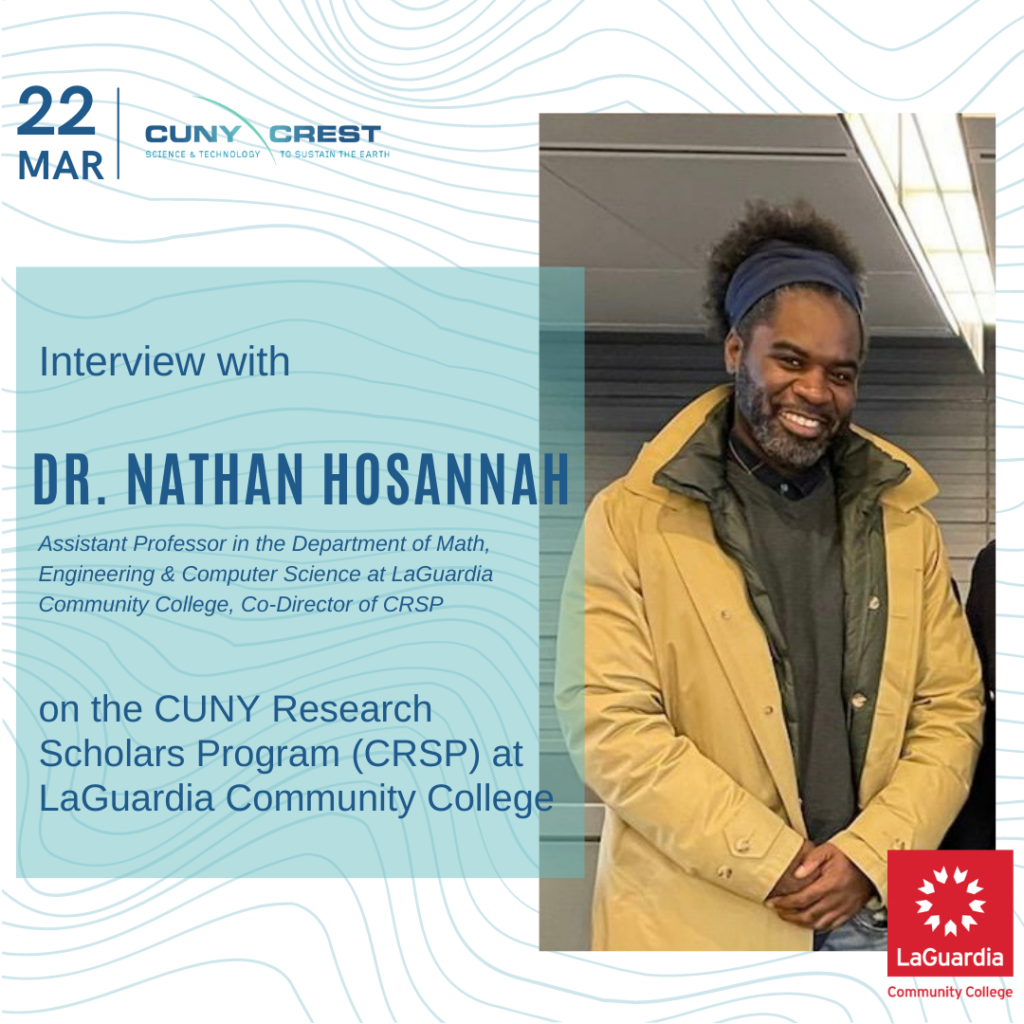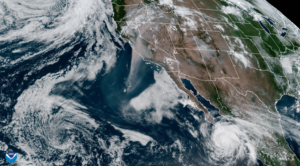Interviewing Co-Director, Dr. Nathan Hosannah speaks out on the CUNY Research Scholars Program (CRSP) at LaGuardia Community College
Dr. Nathan Hosannah is an Assistant Professor in the Department of Math, Engineering & Computer Science at LaGuardia Community College. Dr. Hosannah’s research interests are in land-atmosphere interactions in the coastal environment. He is one of the many great scientists who are affiliated with the CUNY CREST Institute. One of Dr. Hosannah’s passions is mentoring students that are interested in Earth and Atmospheric Systems sciences.
Dr. Hosannah is also a Co-director of the CUNY Research Scholars Program (CRSP) at LaGuardia Community College. The CRSP program funds research experiences for students completing their associate degree at all seven CUNY community colleges and three comprehensive schools. The goal for CRSP is to “encourage undergraduate participation in authentic research and to increase persistence in STEM disciplines”. The program provides students the opportunity to conduct research with the faculty members from the affiliated schools and present their research for the CRSP Symposium.
The CUNY CREST Institute team congratulates Dr. Nathan Hosannah on his position and honored for his ongoing work with students. This interview was conducted by Carolina Perez (Administrative Associate, CUNY CREST Institute) and Dr. Nathan Hosannah to discuss more on CRSP, his current role, and how the program impacts students.
How does the CUNY Research Scholars Program support students?
I am currently one of the CO directors of the CUNY Research Scholars Program (CRSP). The other director is Dr. Roman Senkov of the Natural Sciences Department at LaGuardia Community College. We aim to pair mentors and mentees to conduct research so that students may gain research experience with some incredible faculty. It’s a really great chance for students who are STEM based and inclined to conduct research to gain experience. We have also included the opportunity for students who are interested in the social sciences, to become a part of the program as well. We have an anthropologist, we have psychology, we have engineers across the board, we have physicists, we have biologists, who are all leading students, and conducting research. The beautiful thing about the program is that it supports students across a wide range of not only areas, but also backgrounds. Many students don’t get the opportunities to do research because some research programs require that student be citizens or permanent residents, whereas CRSP does not have this requirement and we are able to support students that would not have had the opportunity to do research outside of the CRSP program.
What type of projects have some of the CRSP student been working on/have worked on?
There is a computer science-based project run by one of the professors of the M.E.C. department at LaGuardia. In this project, he looks at cybersecurity. He looks into keystrokes and different parameters of computational communication, such as emails. In addition to emails, he also works with correspondence through messaging apps. He looks for anomalies in the data and aims to enhance cyber security. We have another project that is based, in weather and climate [the mentor of this project being Dr. Nathan Hosannah]. The student that I have now is comparing how the aerosol intensity in a mega city such as New York might compare to the aerosol intensity in his homeland, which is Dhaka, Bangladesh. He [the student] is now looking at satellite data in order to quantify those differences. Then he will go one step further and try to connect how those aerosol intensities may impact the weather and impact the climate in those regions.
Another mentor-mentee pair is studying how heat affects a cantilever beam. There are several different types of projects, with a wide range of faculty and a wide range of different skill sets. As director, I am able to learn about many different interesting investigations. I’m happy to be in this position.
How can other scientists within our community help the CRSP program at LaGuardia Community College?
I think that one of the ways that would help is to spread the word. Some students are aware of opportunities, because they actively go searching for these opportunities. Other students may not be aware until it’s too late. It’s really about spreading the word, increasing communication, and collaborative events. One of the things that I do is invite scientists, engineers, and business folk to attend our CRSP workshops and speak directly to the students. Not only for teaching them different skill sets that are used and for showing how their coursework applies to the real world, but also, by presenting opportunities for internships. As students elevate, and go beyond CRSP, there are often opportunities to network with these folks and build opportunities; allowing for possible hiring where the experts work. One of the things that I think will be good to include would be more scientists from CCNY. To date I’ve already included two CCNY alumni. I would also like to work with a lot more professors and programs such as NOAA CESSRST. So you see, from a very early stage at the community college level what type of research students are capable of conducting. You get to see which students have an affinity towards the atmospheric sciences and Earth system sciences. I’ve already started to tell my students about NOAA CESSRST opportunities, opportunities across different institutions, and within different organizations. They [students] are beyond themselves to know that these opportunities really do exist. I think that it’s about one hand washing the other. We want our students to graduate and move beyond.
Our workshops are not only available for CRSP students, we like to have other students come and learn from the presenters. We have connected with another research group on campus known as NIH Bridges. We constantly host dual events between our students and the NIH Bridges scholars as well. We are also building a community. We think that by connecting undergraduate students from the community college level to the undergraduate students at the four year level, we are further expanding the network and also necessary opening the pipeline and strengthening the conduit through which these students want to go.
When is the best time for students to apply to CRSP?
We [CRSP] normally begin the program in September. That program runs one year until August. When August comes around the students will present their work at a symposium. We start spreading the word that we are looking for students to apply on a rolling basis, but we really begin to look at applications in April. We take applications until late June. By August, we already know and have communicated with the students and the mentors for the next academic year.
Not only is CRSP at LaGuardia, it exists across the community colleges within CUNY. Guttman has a CRSP, BMCC has a CRSP, Hostos has a CRSP, and so on. Just the knowledge of what CRSP does is important for people to know because I don’t think that many know how spread wide it is and that it connects across boroughs and within CUNY.


